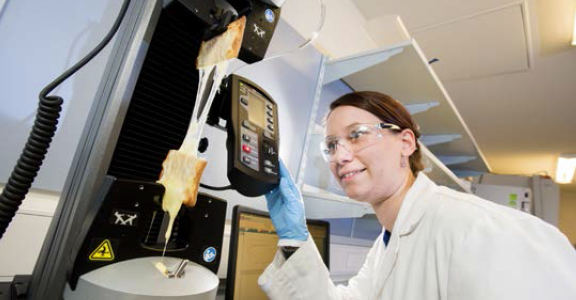Anita with her stretching machine.
The secrets of mozzarella cheese are being unravelled by PhD student Anita Pax.
Anita from the University of Melbourne and The Bio 21 Institute is working in the ARC Dairy Innovation Hub to help mozzarella producers improve their manufacturing process.
Melbourne, with its strong representation of Italian migrants, is mad about mozzarella. The traditional knowledge of making mozzarella was brought to Australia. Now, mozzarella is produced on an industrial scale, but manufacturers are keen to retain the properties that make mozzarella great.
"Mozzarella cheese is a popular choice for pizza because it melts nicely. You get an even coating and a nice nut-brown colour when it's heated. When you lift it, you get all the strands," said Anita.
"I am looking at the properties of cheese and how this is reflected in its molecular structure. I want to understand why it stretches. I am also comparing cheeses for use in pizzas," she said.
Commercial pizza ovens are heated at 400 degrees Celcius. Anita replicates these conditions by melting the mozzarella cheese on a cracker at 240 degrees Celcius, for five minutes.
The sample is then transferred to an instrument called an Instron mode that measures the force required to stretch cheese. It pulls the cheese up at a constant speed.
"The machine measures the stretch quality at two different lengths. More energy is required to do this at the start as it stretches," Anita said.
Cheese is made of milk, bacteria, rennet (the enzyme that coagulates milk) and salt. This combination can create endless possibilities.
Milk, lactic acid, bacteria and rennet are heated to 38 degrees Celcius, an ideal temperature for the bacteria to divide.
As the bacteria multiply, the whey (liquid) and curd (solid milk proteins) separate out. This is a result of the pH, or acidity, dropping due to the bacterial metabolites.
"The solid milk protein, called 'curd' is cut into one cm cubes and allowed to set for 40 minutes, creating a milk 'gel'. On a microstructural level, this is a jumble of protein and fat," Anita said.
The liquid whey is drained off leaving the curd at a pH of 5.1 – 5.2, which is ideal for stretching. Curd is then heated in boiling salty brine and taken out intermittently and stretched. Following this, the curd is moulded into shaped blocks or balls and packaged for consumption.
"One critical step in mozzarella manufacture appears to be when the curd is heated in a salty water bath, taken out and repeatedly compressed and stretched in one direction," said Anita.
"This was traditionally done by hand, but industrially this process is replicated using two large screws that push and stretch the curb attached to them," she says.
Variables that can affect the stretchability of mozzarella include the type of milk, temperature, pH conditions for the lactic acid bacteria (e.g. if the pH is too low, the whey becomes fattier); mechanical forces, e.g. machines stretching cheese, the saltiness of the brine.
The research group compares samples from different manufacturers and looks at the microstructure of the different products. The microstructure gives a good indication of the changes occurring in the cheese.
In mozzarella the protein strands are lined up. This kind of microstructure is related to the stretching. This contrasts with cheddar cheese that has a microstructure more reminiscent of a web, where the fat is more evenly dispersed.
Anita has a scientific approach to her work and benefits from the access to the instruments such as Electron Microscopes and optical microscopes to investigate the dairy microstructure.
Provided by University of Melbourne




















